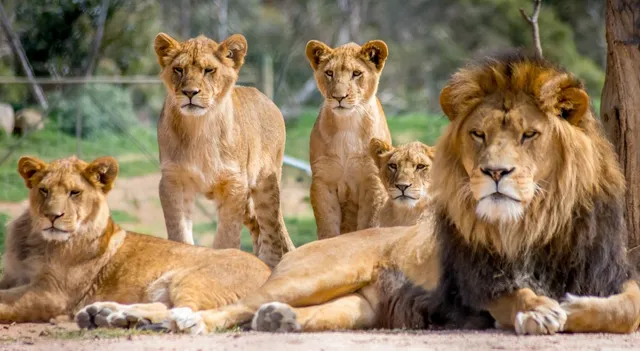- By Ridam Sharma
- Sat, 09 Aug 2025 05:41 PM (IST)
- Source:JND
World Lion Day 2025: World Lion Day is marked every year on August 10th. The day is celebrated to honour one of the most revered and majestic predators in the world. Lions are usually known as the ‘King of the Jungle,’ the one who is known for its charming manes and life-threatening roars. However, there is so much more to this dangerously unique animal. Beneath the dangerous presence of a lion is a much more complicated social structure, surprising behaviours, and fascinating adaptations that make animal enthusiasts and even ordinary people curious. This year, to honour these Kings of the jungle, here is a list of more than 30 lesser-known facts about lions, as per thefactfile.org.
30+ Lesser-Known Facts About Lions For World Lion Day 2025:
Social And Behavioural Facts About Lions:
1. Lions are the only genuinely social big cats, living in groups or pride of up to 30 members made up of related females, their cubs, and a few males.
2. Most of the hunting is carried out by lionesses within the pride, while males primarily defend territory but dine first after a kill.
3. Lions hunt in groups, employing tactics such as circling prey or ambushing in groups.
4. Yawning is also contagious in lions and synchronises group activity, such as hunting or travelling.
5. Lions not only communicate by roaring, but also by purring, meowing, head rubbing, and licking to form close relationships.
6. The lion cubs are born with spots that disappear as they grow up and serve to camouflage them at an early age.
7. Lions roar to mark territory and consolidate social relationships; the cubs start joining in at 2–3 months of age.
Physical And Biological Facts About Lions:
8. A lion's roar can be heard from 5 miles away, which 8 km. And the roar measures around 114 decibels, which is almost as loud as a chainsaw.
9. Male lions' manes are a display of power and status. for example, the darker and fuller the mane, the more desirable and dominant the lion.
10. Lions also have the ability to open their jaws as wide as around 1 foot.
11. Their tongues contain small spines named papillae that strip flesh from bones but are coarse enough to cause pain to human skin.
12. A lion's heart is proportionally small compared to its body size, and males' hearts are approximately 0.45% of body weight.
13. Their padded toes make them silent stalkers when hunting.
14. Lions are able to sprint at speeds of up to 50 mph for short distances and jump up to 36 feet.
Also Read: Viral Video Of Woman’s Cozy Cuddles With Rescued Lion Cubs Is Too Cute To Miss! WATCH
Habitat And Distribution Facts About Lions:
15. Lions used to majorly found in Africa, Europe, Asia, and North America, but currently,these animal kings also live in sub-Saharan Africa, as well as a small Asiatic subspecies in India's Gir Forest.
16. Lions are not the jungle's king. They prefer to inhabit grasslands and savannahs, not jungles.
17. Lions can thrive in dry deserts, tapping water from prey.
18. They tend to kill near water sources because prey animals must drink there.
Diet And Hunting Trivia About Lions:
19. Lionesses do 85-90% of the hunting.
20. Although powerful, lions succeed in hunts on only an estimated 20-25% of attempts.
21. Lions can consume as much as 40 kg (roughly a quarter of their body weight) in one meal.
22. Hunting may be done at night or during storms when prey is less vigilant.
23. A lion requires an average of 5 kg (female) to 7 kg or more (male) of meat per day.
Reproductive And Lifespan Trivia About Lions:
24. Lion pregnancies are approximately 110 days, quite extended for cats.
25. They give birth to cubs at the same time, and communal raising is practised.
26. Lions live to 10-14 years in the wild and 20 years; females live longer than males.
27. The cubs remain concealed in dens for weeks before becoming part of the pride.
Conservation And Threats For Lions:
28. Wild lion populations have declined by over 40% in the past two decades, with around only 23,000 left in the wild.
29. The main threats to lions are habitat loss, poaching, human-wildlife conflict, and prey depletion.
30. Conservation efforts include protected reserves like India’s Gir Forest for Asiatic lions and African national parks.
Additional Interesting Facts About Lions:
31. Lions have black-tipped tails, which help cubs see their mother in tall grass.
32. Lions do not chew and instead shred their food with their teeth to swallow.
33. Lions rest as much as 20 hours per day to save energy for hunting and defending territory.
34. Lions have been admired in human culture as symbols of power, courage, and royalty.
Lions are far more than just dangerous predators. They are protectors of their environments, complex social animals, and a living epitome of bravery and survival. However, their survival balance gets significantly influenced by habitat destruction, human conflict, and declining prey species. World Lion Day 2025 is not just a celebration but also a much-needed call to action that the future of these lions lies in our hands. Learning, sharing, and supporting conservation works will help us make sure that the lion's roar echoes on the savannah for ages to ahead.

